When Winter Weather Threatens Your Home's Plumbing
Frozen pipe repair becomes a critical concern when temperatures drop below 20°F, putting your plumbing at serious risk. Most freezing pipe claims occur between December and February. A single burst pipe can release up to 250 gallons of water in 24 hours, causing thousands in damage.
Quick Action Steps for Frozen Pipes:
- Locate the frozen section - Check faucets for reduced water flow
- Open the affected faucet - This relieves pressure as ice melts
- Apply gentle heat - Use a hair dryer, heating pad, or hot towels
- Shut off main water - If you find a burst pipe
- Call a professional - For pipes behind walls or if DIY fails
The key is to act quickly with safe thawing methods. When water freezes, it expands, creating intense pressure that can rupture pipes. The damage often occurs between the ice blockage and your faucet, not at the frozen spot itself.
This guide will show you how to identify and safely thaw frozen pipes, make temporary repairs, and prevent the problem from happening again. Whether you're dealing with a slow trickle or frost on exposed pipes, you'll learn what to do.
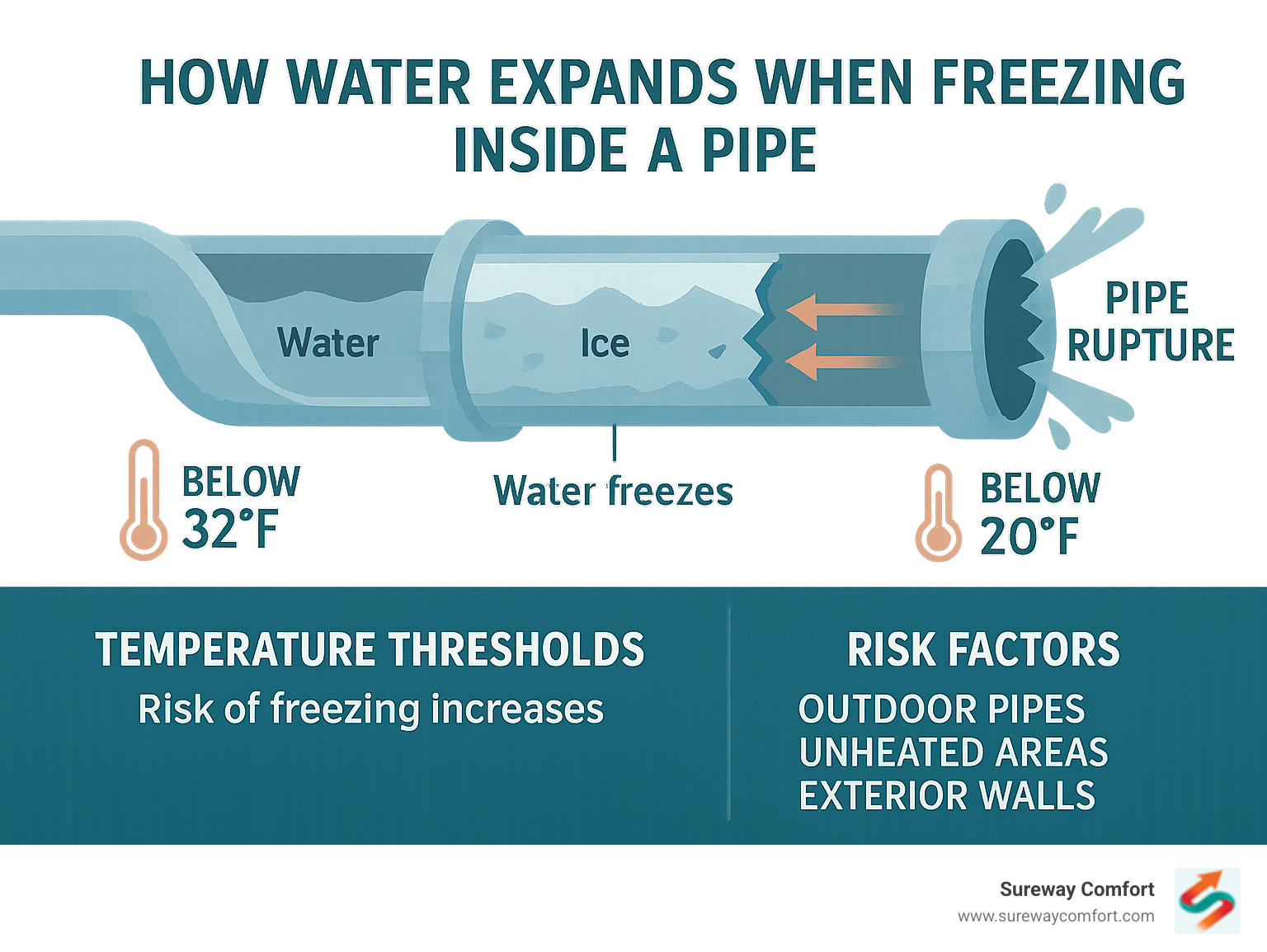
Why Pipes Freeze and How to Spot the Problem
Understanding why pipes freeze and spotting the signs early can save you from a costly disaster.
Common Causes of Frozen Pipes
The critical temperature for pipe trouble is 20°F. While water freezes at 32°F, pipes are generally safe until the temperature drops to 20°F or below, when the cold can penetrate your home's insulation.
The most vulnerable pipes are in unheated areas like attics, crawl spaces, garages, and along exterior walls. Poor insulation is another major cause; gaps or cracks let cold air in, freezing even interior pipes. Setting your thermostat too low (below 55°F) also increases risk, especially when you're away.
When water freezes, it expands with immense force. This pressure often causes frozen pipe repair emergencies between the ice and the faucet, not at the freeze itself.
Telltale Signs of a Frozen Pipe
Your home gives warning signs before a pipe bursts. Recognizing them can prevent a major emergency.
The most obvious sign is no water flow or just a trickle from a faucet, indicating an ice blockage.
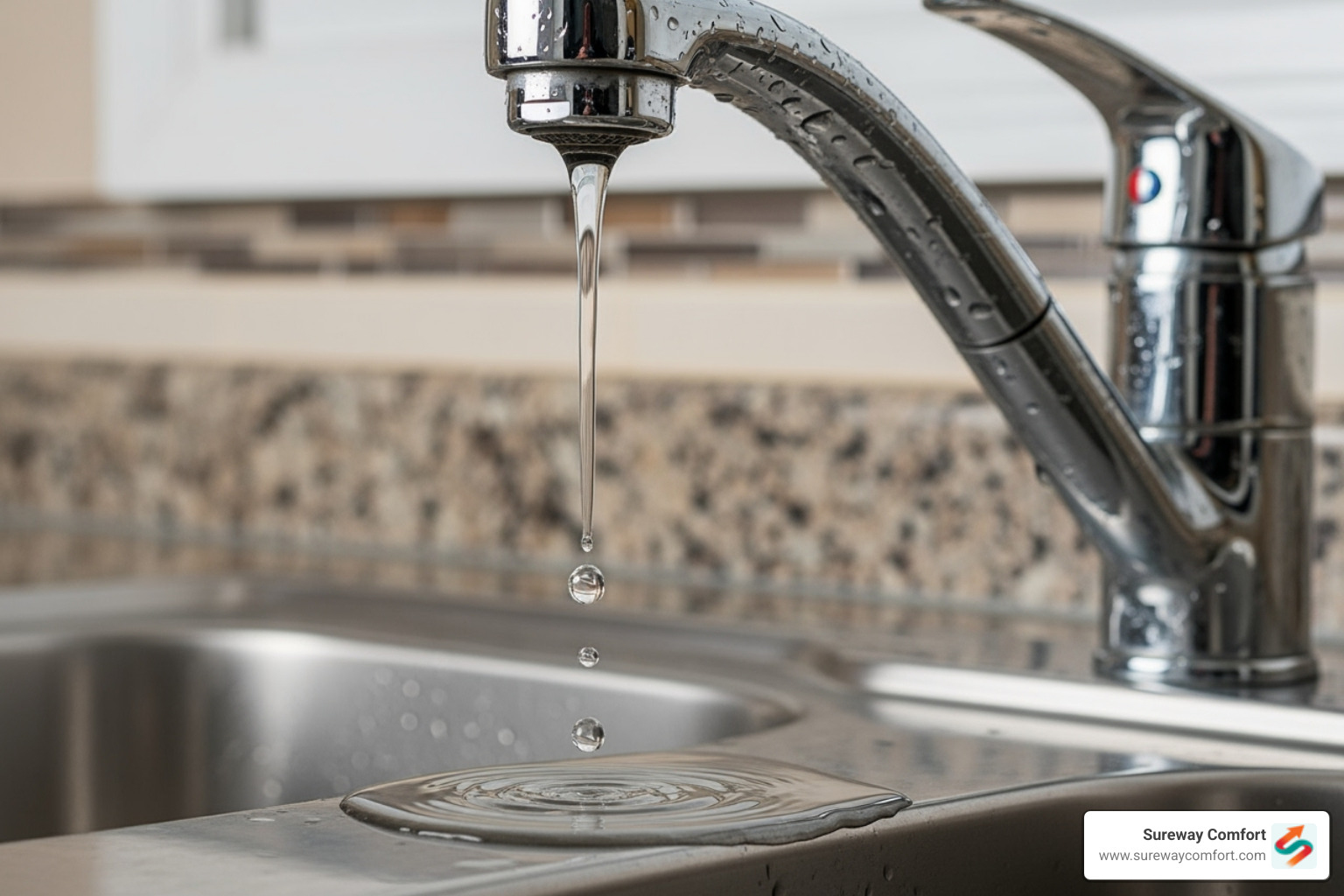
Look for frost on the outside of visible pipes in basements or under sinks. Visible bulges on a pipe mean it's under extreme stress and could burst soon.
Strange smells from drains can indicate a frozen pipe is causing a backup. You might also hear gurgling or banging sounds from walls as water struggles to move past ice.
If you notice any of these signs, act quickly to avoid a burst pipe and the need for emergency frozen pipe repair services.
Your Immediate Action Plan for Frozen Pipes
When you find a frozen pipe, acting quickly is key to avoiding a burst pipe disaster.
First Steps to Take
Your first step is to locate the frozen section. Turn on all faucets to find which lines are frozen. No water or a trickle identifies the problem area. Trace the line by checking pipes in the basement, crawl space, attic, and under sinks for frost or bulges.
Once found, open the affected faucet and leave it open. This is crucial for frozen pipe repair as it relieves pressure while the ice melts, preventing a burst.
Most importantly, locate your main water shut-off valve. If a pipe has already burst, you must shut off the water immediately to prevent flooding.
Safe Methods for Thawing Pipes
When thawing, be patient and use gentle heat. Applying too much heat too quickly can damage the pipe.
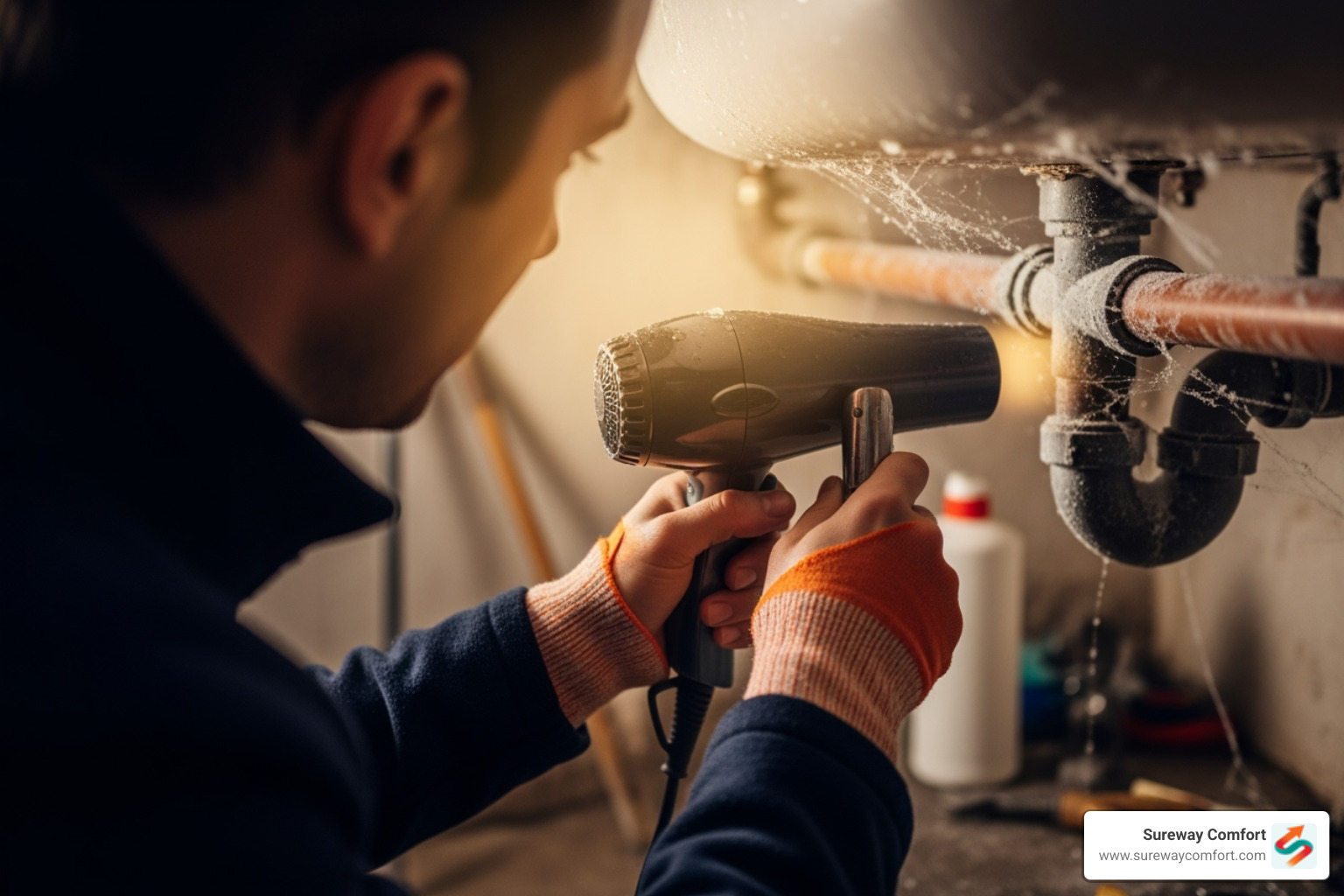
A hair dryer on a low setting is a good option for exposed pipes. Keep it moving and start near the faucet, working toward the blockage. An electric heating pad provides steady warmth, and hot towels are also effective—just soak, wring, and wrap them around the pipe. For larger areas, a portable space heater can warm the air, but keep it away from flammable materials and never leave it unattended.
Safe thawing tools include hair dryers, electric heating pads, hot water-soaked towels, portable space heaters, and UL-listed electrical heating tape with thermostat controls.
Dangerous Thawing Methods to AVOID
It's vital to know which thawing methods to avoid.
Never use open flames like a propane torch. They can damage pipes or start a fire. Also, avoid pouring boiling water on a frozen pipe, as the sudden temperature change can cause it to crack.
Be careful with electrical devices near water. Use GFCI outlets and ensure the area is dry. If you're ever unsure about frozen pipe repair, it's safest to call a professional. For more tips, see this guide to safe home repairs.
Handling a Burst Pipe: Temporary Fixes and Professional Frozen Pipe Repair
A burst pipe is a nightmare, but knowing what to do in the first few minutes can save you thousands in damage.
Emergency Temporary Repair for a Burst Pipe
When you find a burst pipe, your first mission is damage control.
Shut off the main water supply immediately. It's usually near the water meter. If you can't find it or it's stuck, call your utility company. If the burst is near electrical wiring, shut off the electricity at the circuit breaker. After shutting off the water, open all faucets to drain the system and relieve pressure.
Temporary fixes can buy you time. A pipe repair clamp, available at hardware stores, is a rubber sleeve that clamps over small cracks.
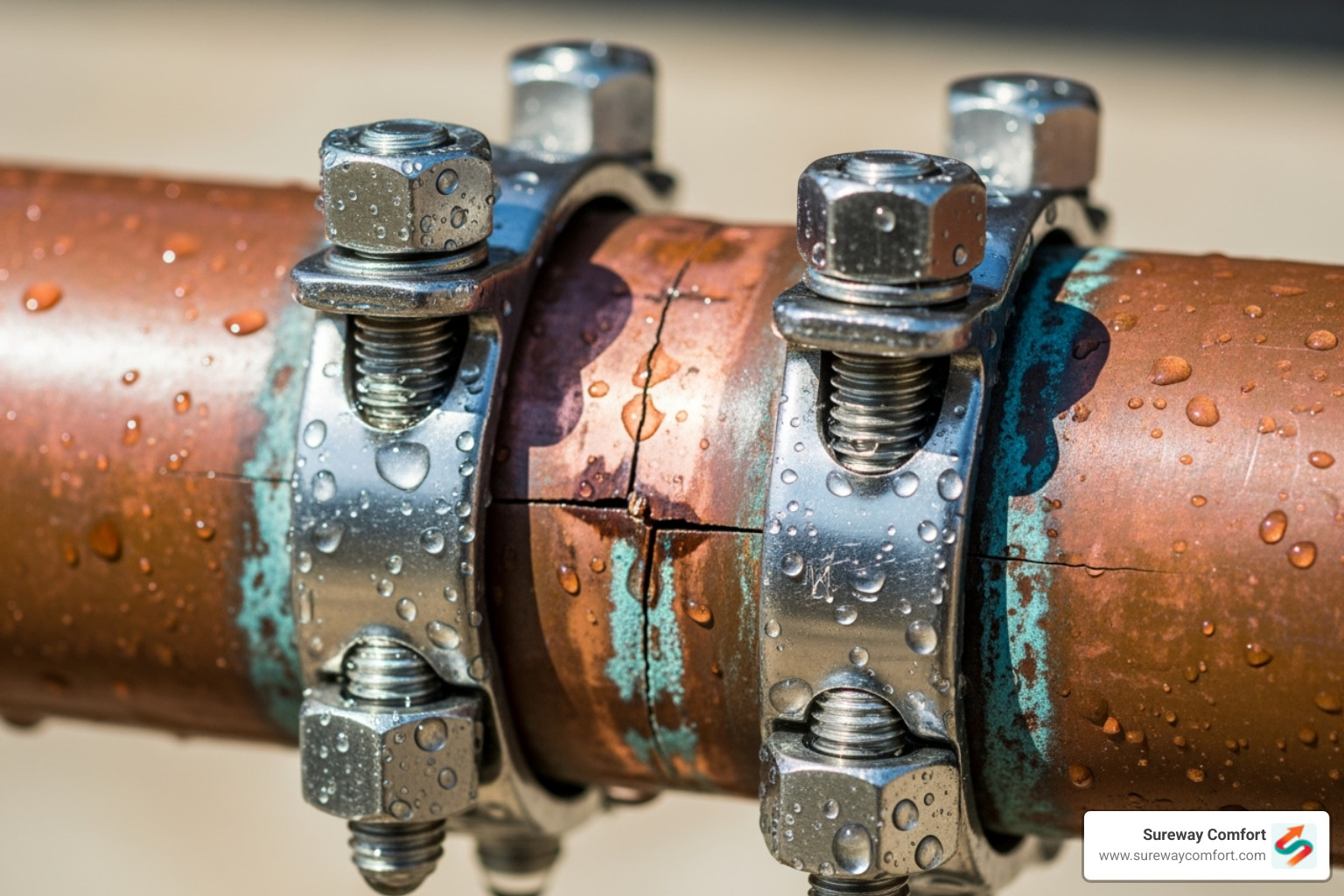
For small holes, epoxy putty or a rubber patch secured with hose clamps can work as a temporary seal. These are temporary. You'll need professional frozen pipe repair for a permanent solution.
Understanding the Costs of Frozen Pipe Repair
Understanding the potential costs helps you make smart decisions. Thawing a frozen pipe before it bursts is relatively inexpensive, costing around $100.
Burst pipe repairs are more expensive, averaging $500 but can range from $150 to over $5,000 for extensive damage. The biggest expense is often water damage. A burst pipe can release 250 gallons of water a day, soaking drywall, flooring, and furniture, and leading to mold.
Plumber rates average $330 per hour. Check your insurance policy, as many cover burst pipe flooding, and document all damage with photos. You can learn more about insurance claims for frozen pipes.
If you're in our area, we're here to help with comprehensive Plumbing Services in Bridgeville, PA.
When to Call a Professional Plumber
Some situations are DIY-friendly, but others require a professional.
Call a professional immediately if a pipe has burst. This is an emergency. Turn off your water and get help on the way.
Also call a pro if:
- You can't find the freeze.
- DIY thawing fails after an hour.
- The frozen pipe is behind a wall or inaccessible.
- You're uncomfortable with DIY repair. Safety is paramount, and a pro ensures the job is done right.
Beyond frozen pipe repair, we also provide expert Drain Cleaning Services to keep your entire plumbing system running smoothly.
Long-Term Prevention: Your Winterization Checklist
The best frozen pipe repair is the one you never have to make. A little prevention can save you from a burst pipe disaster on a cold winter night.
Insulating Your Plumbing System
Insulation is your most important defense against frozen pipes.
Pipe sleeves and foam insulation are inexpensive and effective for exposed pipes in basements, crawl spaces, and attics. Ensure they fit snugly and seal any joints with tape. For vulnerable pipes, consider heat tape or heat cable. These thermostat-controlled devices provide warmth to keep water flowing.
Sealing cracks and openings in walls and foundations with caulk or foam prevents cold air from reaching your pipes. Also, insulating crawl spaces and attics helps keep the entire area warmer, protecting the pipes within.
We also offer expert Water Heater Repair Services to ensure your hot water supply is never compromised during the coldest months.
Everyday Habits for Cold Snaps
Simple daily habits during cold snaps also make a big difference.
- Let faucets drip with a tiny trickle of cold water to prevent ice from forming in vulnerable pipes.
- Open cabinet doors under sinks to allow warm air from your home to circulate around the pipes.
- Keep your thermostat set to at least 55 degrees Fahrenheit, even when you're away. The extra heating cost is minimal compared to repairing water damage.
- As part of your fall routine, drain outdoor lines, including sprinklers. Disconnect and drain garden hoses, and use insulated covers on outdoor faucets.
- Seal drafts around windows and doors, especially near pipes, to block cold air and improve heating efficiency.
For comprehensive warmth and comfort throughout your home, remember to service your heating system regularly. Learn more about our Heating Services to keep your whole house cozy while protecting your plumbing.
Frequently Asked Questions About Frozen Pipes
Here are answers to common questions about frozen pipes.
How long does it take for pipes to unfreeze on their own?
Pipes might thaw on their own in a day or two once temperatures rise, but waiting is risky. The pressure from the ice blockage can cause the pipe to burst as it thaws. It's much safer to actively thaw the pipe or call a professional for frozen pipe repair. Waiting is not a safe option, especially if cold weather persists.
Can I pour hot water down the drain to thaw a pipe?
No. Pouring boiling water down a drain or onto a pipe can cause a sudden temperature change, which can crack the pipe (especially PVC). The hot water can also cool and worsen the freeze, and steam can build pressure or cause burns. Stick to gentle, safe thawing methods.
Which pipes are most likely to freeze?
Pipes in unheated or poorly insulated areas are most likely to freeze. The usual suspects include:
- Basements and Crawl Spaces: Pipes along exterior walls in unheated or poorly insulated areas.
- Attics: Plumbing lines in an unheated attic.
- Garages: Water lines in an unheated garage.
- Exterior Walls: Pipes inside exterior walls have less insulation and are exposed to outdoor temperatures.
- Under Sinks: Pipes under sinks on exterior walls can freeze if cabinet doors are closed, blocking warm air.
- Copper Pipes: Copper pipes lose heat faster than PEX, making them more prone to freezing.
Knowing these risk areas helps you focus your prevention efforts!
Protect Your Home with Professional Plumbing Care
When winter weather hits, a frozen pipe can cause a disaster, releasing hundreds of gallons of water and leading to thousands in damage from ruined floors, furniture, and mold. The good news is that most frozen pipe emergencies are preventable with the right approach and professional support.
Prevention is key for frozen pipe repair. Simple winterization steps can save you headaches and expense. Still, even prepared homeowners can face unexpected plumbing issues.
That's where a trusted plumbing partner makes all the difference. At Sureway Comfort, we help homeowners in the greater Pittsburgh area steer winter plumbing challenges. Our experienced technicians know the issues pipes face in Bridgeville, South Fayette, Upper St. Clair, Mt. Lebanon, McDonald, Scott Township, Canonsburg, and Bethel Park during our brutal winters.
Our streamlined process gets you fast, professional help. We offer maintenance plans to prevent problems before they become costly emergencies, giving you peace of mind all winter. Plumbing emergencies are never convenient, which is why we offer flexible financing options to make crucial repairs accessible when you need them. Your family's comfort and home's protection shouldn't wait.
For peace of mind and expert frozen pipe repair services, trust our team to protect your home. Don't wait for a disaster to strike—winter weather can change quickly, and preparation is everything. Contact us for reliable plumbing services in Mt. Lebanon, PA today!



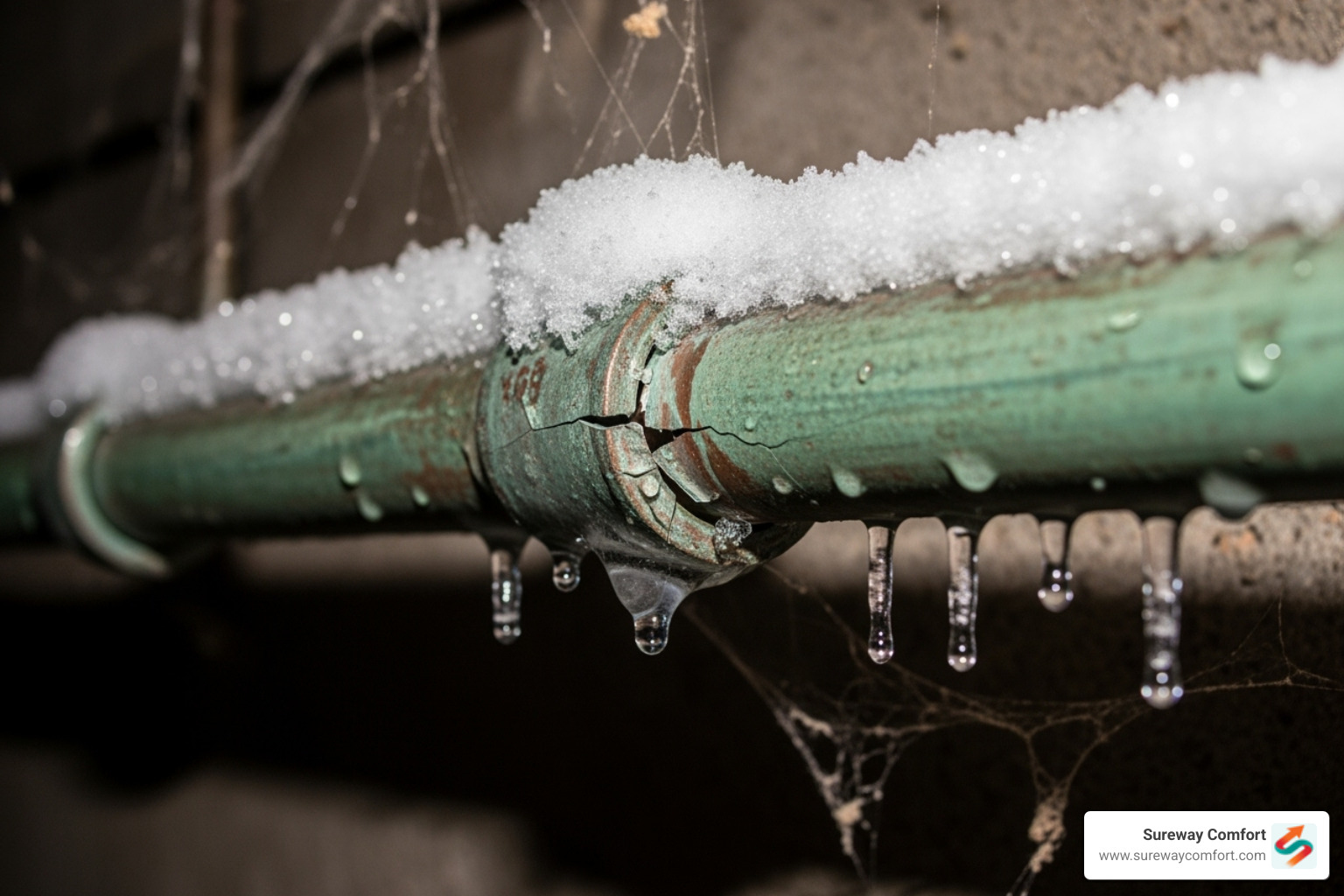



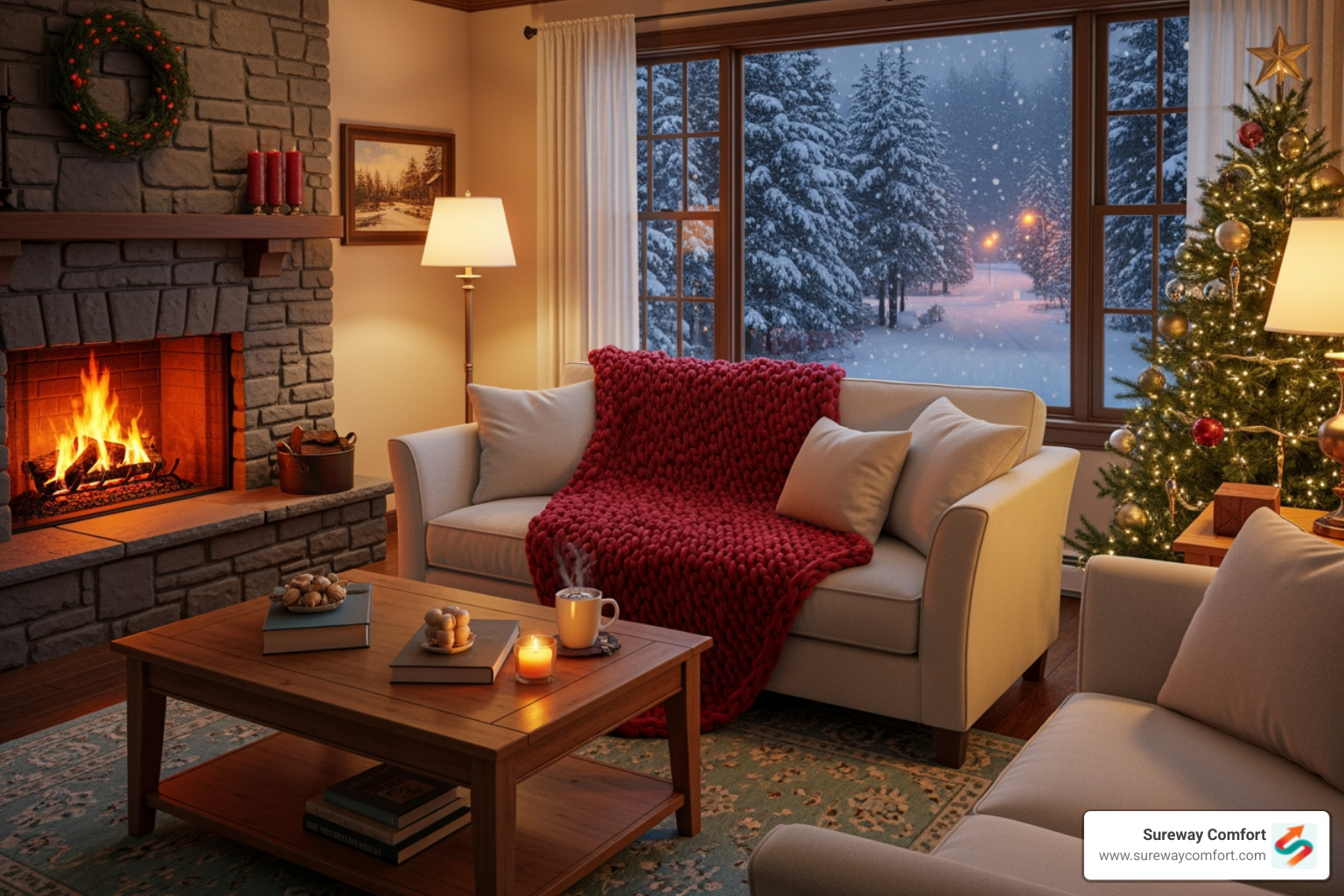




















.avif)



